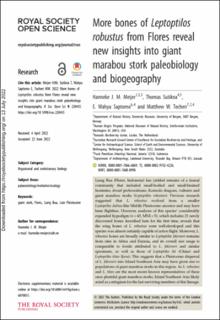| dc.contributor.author | Meijer, Hanneke Johanna Maria | |
| dc.contributor.author | Sutikna, Thomas | |
| dc.contributor.author | Wahyu Saptomo, Saptomo | |
| dc.contributor.author | Tocheri, Matthew W. | |
| dc.date.accessioned | 2023-01-23T15:10:02Z | |
| dc.date.available | 2023-01-23T15:10:02Z | |
| dc.date.created | 2022-08-17T13:57:41Z | |
| dc.date.issued | 2022 | |
| dc.identifier.issn | 2054-5703 | |
| dc.identifier.uri | https://hdl.handle.net/11250/3045453 | |
| dc.description.abstract | Liang Bua (Flores, Indonesia) has yielded remains of a faunal community that included small-bodied and small-brained hominins, dwarf proboscideans, Komodo dragons, vultures and giant marabou storks (Leptoptilos robustus). Previous research suggested that L. robustus evolved from a smaller Leptoptilosdubius-like Middle Pleistocene ancestor and may have been flightless. However, analyses of this species' considerably expanded hypodigm (n = 43, MNI = 5), which includes 21 newly discovered bones described here for the first time, reveals that the wing bones of L. robustus were well-developed and this species was almost certainly capable of active flight. Moreover, L. robustus bones are broadly similar to Leptoptilos falconeri remains from sites in Africa and Eurasia, and its overall size range is comparable to fossils attributed to L. falconeri and similar specimens, as well as those of Leptoptilos lüi (China) and Leptoptilos titan (Java). This suggests that a Pleistocene dispersal of L. falconeri into Island Southeast Asia may have given rise to populations of giant marabou storks in this region. As L. robustus and L. titan are the most recent known representatives of these once plentiful giant marabou storks, Island Southeast Asia likely acted as a refugium for the last surviving members of this lineage. | en_US |
| dc.language.iso | eng | en_US |
| dc.publisher | The Royal Society | en_US |
| dc.rights | Navngivelse 4.0 Internasjonal | * |
| dc.rights.uri | http://creativecommons.org/licenses/by/4.0/deed.no | * |
| dc.title | More bones of Leptoptilos robustus from Flores reveal new insights into giant marabou stork paleobiology and biogeography | en_US |
| dc.type | Journal article | en_US |
| dc.type | Peer reviewed | en_US |
| dc.description.version | publishedVersion | en_US |
| dc.rights.holder | Copyright 2022 the authors | en_US |
| dc.source.articlenumber | 220435 | en_US |
| cristin.ispublished | true | |
| cristin.fulltext | original | |
| cristin.qualitycode | 1 | |
| dc.identifier.doi | 10.1098/rsos.220435 | |
| dc.identifier.cristin | 2043847 | |
| dc.source.journal | Royal Society Open Science | en_US |
| dc.identifier.citation | Royal Society Open Science. 2022, 9 (7), 220435. | en_US |
| dc.source.volume | 9 | en_US |
| dc.source.issue | 7 | en_US |

